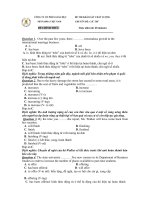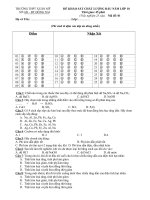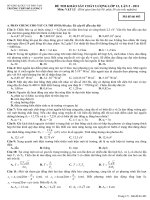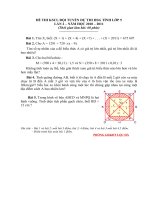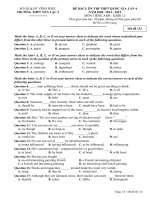Đề thi Khảo sát chất lượng Tiếng anh 2019 Trường Đồng Đậu, Vĩnh Phúc lần 1 mã đề 103 - Học Toàn Tập
Bạn đang xem bản rút gọn của tài liệu. Xem và tải ngay bản đầy đủ của tài liệu tại đây (423.83 KB, 5 trang )
<span class='text_page_counter'>(1)</span><div class='page_container' data-page=1>
<b>SỞ GIÁO DỤC VÀ ĐÀO TẠO </b>
<b>THPT ĐỒNG ĐẬU </b>
<b>ĐỀ THI KHẢO SÁT CHẤT LƯỢNG LỚP 12 LẦN 1 </b>
<b>MÔN : TIẾNG ANH </b>
<b>NĂM HỌC 2018-2019 </b>
<i>Thời gian làm bài: 60 phút </i>
<i>Đề gồm 50 câu </i>
<b>Mã đề thi 103 </b>
Họ, tên thí sinh:...
Số báo danh:...
<i><b>Read the following passage and mark the letter A, B, C, or D on your answer sheet to indicate the </b></i>
<i><b>correct answer to each of the questions. </b></i>
The Singapore Science Centre is located on a six-hectare site in Jurong. At the centre, we can
discover the wonders of science and technology in a fun way. Clap your hands and colorful bulbs will
light up. Start a wheel spinning and it will set off a fan churning. It is a place to answer our curiosity
and capture our imagination.
The centre features over four hundred exhibits covering topics like solar radiation, communication,
electronics, mathematics, nuclear energy and evolution. <i><b>It</b></i> aims to arouse interest in science and
technology among us and the general public. The centre is the first science one to be established in
South East Asia. It was opened in 1977 and it now receives an average of one thousand, two hundred
visitors a day. The exhibits can be found in four exhibition galleries. They are the Lobby, Physical
Sciences, Life Sciences and Aviation. These exhibits are renewed annually so as to encourage visitors
to make return visits to the centre.
Instead of the usual <i><b>“Hands off”</b></i> notices found in exhibition halls, visitors are invited to touch and
feel the exhibits, push the buttons, turn the cranks or pedals. This is an interesting way to learn
science even if you hate the subject. A Discovery Centre was built for children between the ages of
three and twelve. This new exhibition gallery was completed in 1985. Lately this year a stone-age
exhibit was built. It shows us about the animals and people which were extinct.
<b>Câu 1:</b> What can be the best title of the passage?
<b>A. </b>Discovery Centre <b>B. </b>Science Centre
<b>C. </b>Singapore Science Centre <b>D. </b>Physical Sciences
<b>Câu 2:</b> The word<b> “It” </b>in paragraph 2 refers to ________ .
<b>A. </b>the general public <b>B. </b>the centre <b>C. </b>solar radiation <b>D. </b>evolution
<b>Câu 3:</b> According to the paragraph 2, which of the following is<b> NOT </b>true about the Singapore
Science Centre?
<b>A. </b>The centre is the first one established in the world.
<b>B. </b>The centre was not opened until 1977.
<b>C. </b>Visitors are encouraged to return to the centre.
<b>D. </b>The exhibits in the centre cover a wide range of topics.
<b>Câu 4:</b> It is stated in paragraph 2 that __________.
<b>A. </b>the science centre makes people interested in science and technology
<b>B. </b>there are only several exhibits in the science centre
<b>C. </b>only students can visit the science centre
<b>D. </b>visitors don’t want to come back to the science centre
<b>Câu 5:</b> What does<b> “Hand off” </b>in paragraph 3 means?
<b>A. </b>Keep away <b>B. </b>Touch <b>C. </b>Don’t touch <b>D. </b>Don’t stand on
<b>Câu 6:</b> It is indicated in paragraph 3 that _________.
</div>
<span class='text_page_counter'>(2)</span><div class='page_container' data-page=2>
<b>B. </b>children under 3 are not allowed to visit the centre
<b>C. </b>it is impossible for visitors to touch and feel the objects in the centre
<b>D. </b>the <b>“Hand off”</b> notice is not found in the centre
<b>Câu 7:</b> The author mentions all of the following in the passage EXCEPT_________.
<b>A. </b>There are four exhibition galleries in the centre.
<b>B. </b>The centre is located in Jurong
<b>C. </b>The exhibits are renewed every year.
<b>D. </b>The centre is the biggest in Asia.
<i><b>Read the following passage and mark the letter A, B, C or D on your answer sheet to indicate the </b></i>
<i><b>correct word or phrase that best each of the numbered blanks. </b></i>
Most people think of computers as very modern inventions, products of our new technological age.
But actually the idea for a computer had been worked out over two centuries ago by a man
(8)_________ Charles Babbage. Babbage was bom in 1791 and grew up to be a brilliant
mathematician. He drew up plans for several calculating machines which he called "engines". But
despite the fact that he (9)_________ building some of these, he never finished any of them. Over the
years, people have argued (10)_________ his machines would ever work. Recently, however, the
<i>Science Museum in London</i> has finished building(11)_________ engine based on one of Babbage's
designs. (12)_________ has taken six years to complete and more than four thousand parts have been
specially made.
Whether it works or not, the machine will be on show at a special exhibition in the Science
Museum to remind people of Babbage's work.
<b>Câu 8: </b> <b>A. </b>recognized <b>B. </b>known <b>C. </b>written <b>D. </b>called
<b>Câu 9: </b> <b>A. </b>wanted <b>B. </b>made <b>C. </b>missed <b>D. </b>started
<b>Câu 10: A. </b>why <b>B. </b>whether <b>C. </b>until <b>D. </b>though
<b>Câu 11: A. </b>that <b>B. </b>an <b>C. </b>some <b>D. </b>the
<b>Câu 12: A. </b>One <b>B. </b>It <b>C. </b>They <b>D. </b>He
<i><b>Read the following passage and mark the letter A, B, C, or D on your answer sheet to indicate the </b></i>
<i><b>correct answer to each of the questions. </b></i>
Smart cards and mobile phones are becoming an increasingly popular way to make all sorts of
payments. Even now, in Japan thousands of transactions, from paying rail tickets to picking up the
groceries, take place every day with customers passing their handsets across<b> a small flat-screen </b>
<b>device</b>. And predictions in the world of finance reckon that payments using mobile phones will have
risen to more than $50 billion in the very near future.
What's the appeal of e-cash? Compared to cheques or credit cards, it offers the speed of
cash, but more so. It takes just one tenth of a second to complete most transactions and as no change
is required, errors in counting are eliminated. Fraud and theft are also reduced and for the retailer, it
reduces the cost of handling money. Sony's vision of having a chip <b>embedded</b> in computers, TVs and
games consoles means that films, music and games can be paid for easily without having to input
credit card details.
And what about the future of the banks? Within their <b>grip</b> on the market, banks and
credit-card firms want to be in a position to collect most of the fees from the users of mobile and
</div>
<span class='text_page_counter'>(3)</span><div class='page_container' data-page=3>
branches as was predicted. On the contrary, more Americans than ever are using local branches. So,
whether we'll become a totally cash-free society remains open to contention.
<b>Câu 13:</b> What is the main idea of the first paragraph?
<b>A. </b>The absence of traditional payment methods.
<b>B. </b>The increasing popularity of new payment methods.
<b>C. </b>Predictions of future payment methods.
<b>D. </b>Japan's advanced forms of payment.
<b>Câu 14:</b> Why does the author mention "<b>a small flat-screen device</b>" in the first paragraph?
<b>A. </b>to exemplify the e-cash system <b>B. </b>to praise the e-cash system
<b>C. </b>to criticize the e-cash system <b>D. </b>to inform the e-cash system
<b>Câu 15:</b> Which of the following is NOT true about the strong point of e-cash?
<b>A. </b>fewer mistakes <b>B. </b>faster speed <b>C. </b>no fraud <b>D. </b>reduced cost
<b>Câu 16:</b> The word "<b>embedded</b>” in the second paragraph is closest in meaning to _____.
<b>A. </b>generated <b>B. </b>manufactured <b>C. </b>isolated <b>D. </b>integrated
<b>Câu 17:</b> The word "<b>grip"</b> in the third paragraph is closest in meaning to ________.
<b>A. </b>range of branches <b>B. </b>success <b>C. </b>wealth <b>D. </b>power
<b>Câu 18:</b> The author mentions the case of commuters in the third paragraph to illustrate ________.
<b>A. </b>the modern technology of the e-cash system
<b>B. </b>the banks' cooperation with credit-card companies
<b>C. </b>the transferability of the system
<b>D. </b>a possible drawback of the system
<b>Câu 19:</b> The word "<b>their</b>” in the third paragraph refers to ________.
<b>A. </b>American bankers <b>B. </b>high-street hanks <b>C. </b>Internet banking <b>D. </b>credit cards
<b>Câu 20:</b> How does the writer seem to feel about the future of banks?
<b>A. </b>pessimistic <b>B. </b>optimistic <b>C. </b>neutral <b>D. </b>uncertain
<i><b>Mark the letter A, B, C or D on your answer sheet to indicate the underlined part that needs </b></i>
<i><b>correction in each of the following questions.</b></i>
<b>Câu 21:</b> The novel was such interesting that I read it from the beginning to the end in 4 hours.
<b>A. </b>such <b>B. </b>in <b>C. </b>it <b>D. </b>beginning
<b>Câu 22:</b> The lion has long been a symbol of strength, powerful and cruelty
<b>A. </b>symbol <b>B. </b>long been <b>C. </b>powerful <b>D. </b>strength
<b>Câu 23:</b> The policemanwarned the touristsnot walkingaloneinempty streetsat night.
<b>A. </b>at night <b>B. </b>The policeman <b>C. </b>in <b>D. </b>not walking
<i><b>Mark the letter A, B, C or D on your answer sheet to indicate the word or phrase that is CLOSEST </b></i>
<i><b>in meaning to the underlined part in each of the following questions.</b></i>
<b>Câu 24:</b> There was a long period without rain in the countryside last year so the harvest was
poor.
<b>A. </b>epidemic <b>B. </b>flood <b>C. </b>drought <b>D. </b>famine.
<b>Câu 25:</b> Our parents join hands to give us a nice house and a happy home
<b>A. </b>take hand <b>B. </b>shake hands <b>C. </b>work together <b>D. </b>give a hand
<i><b>Mark the letter A, B, C, or D on your answer sheet to indicate the most suitable response to </b></i>
<i><b>complete each of the following exchanges.</b></i>
<b>Câu 26:</b> Jim: “ This dictionary is for you. I hope you will find it useful.”
Mai : " _________."
<b>A. </b>Thanks. I’ll do it <b>B. </b>No problem!
<b>C. </b>Thanks. It’s very kind of you <b>D. </b>Yes, please
</div>
<span class='text_page_counter'>(4)</span><div class='page_container' data-page=4>
- John: "______"
- Mike: "Thanks. I'm glad to hear that."
<b>A. </b>What a nice car! <b>B. </b>Your car is new, isn't it?
<b>C. </b>Where did you buy your car? <b>D. </b>My car is very expensive.
<i><b>Mark the letter A, B, C, or D on your answer sheet to indicate the sentence that best combines each </b></i>
<i><b>pair of sentences in the following questions.</b></i>
<b>Câu 28:</b> They are my two sisters. They aren’t teachers like me.
<b>A. </b>Unlike me, neither of my two sisters aren’t teachers.
<b>B. </b>They are my two sisters, both of those are teachers like me.
<b>C. </b>They are my two sisters, neither of whom is teacher like me.
<b>D. </b>They are my two sisters who neither are teachers like me.
<b>Câu 29:</b> He was very tired. However, he agreed to help me with my work.
<b>A. </b>Because tired he was, he agreed to help me with my work.
<b>B. </b>Tired though he was, but he agreed to help me with my work.
<b>C. </b>As tired as he was, he agreed to help me with my work.
<b>D. </b>Despite being very tired, he agreed to help me with my work.
<i><b>Mark the letter A, B, C or D on your answer sheet to indicate the sentence that is closest in </b></i>
<i><b>meaning to each of the following questions.</b></i>
<b>Câu 30:</b> This is the first time I have attended such an enjoyable wedding party.
<b>A. </b>My attendance at the first wedding party was enjoyable.
<b>B. </b>The first wedding party I attended was enjoyable.
<b>C. </b>I have never attended such an enjoyable wedding party before.
<b>D. </b>I had the first enjoyable wedding party.
<b>Câu 31:</b> She raised her hand high so that she could attract her teacher's attention.
<b>A. </b>She had such a high raising of hand that she failed to attract her teacher's attention
<b>B. </b>Though she raised her hand high, she could not attract her teacher's attention.
<b>C. </b>Because her teacher attracted her, she raised her hand high.
<b>D. </b>To attract her teacher's attention, she raised her hand high.
<b>Câu 32:</b> “ Do you watch television every evening, Jane?”, said Peter.
<b>A. </b>Peter asked Jane did she watch TV every evening.
<b>B. </b>Peter asked Jane if she’d watched TV every evening.
<b>C. </b>Peter asked Jane if she watched TV every evening.
<b>D. </b>Peter asks Jane if does she watch TV every evening.
<i><b>Mark the letter A, B, C or D on your answer sheet to indicate the correct answer to each of the </b></i>
<i><b>following questions</b></i>.
<b>Câu 33:</b> John asked me _______ that film the night before.
<b>A. </b>if had I seen <b>B. </b>if I had seen <b>C. </b>had I seen <b>D. </b>that I saw
<b>Câu 34:</b> John cannot make a __________ to get married to Mary or stay single until he can afford a
house and a car.
<b>A. </b>decide <b>B. </b>decision <b>C. </b>decisive <b>D. </b>decisively
<b>Câu 35:</b> By the end of this month I __________for this company for two years.
<b>A. </b>will have been working <b>B. </b>have been working
<b>C. </b>will work <b>D. </b>will be working
<b>Câu 36:</b> Tom invited us to come to his party, __________?
<b>A. </b>wasn't he <b>B. </b>didn't he <b>C. </b>hadn't he <b>D. </b>couldn't he
<b>Câu 37:</b> There was plenty of time. She _____ .
<b>A. </b>needn't have hurried <b>B. </b>must not hurry
</div>
<span class='text_page_counter'>(5)</span><div class='page_container' data-page=5>
<b>Câu 38:</b> Sometimes she does not agree ___ her husband about child rearing but they soon find the
solutions.
<b>A. </b>with <b>B. </b>of <b>C. </b>for <b>D. </b>on
<b>Câu 39:</b> It is said the Robinhood robbed______ rich and gave the money to ______ poor.
<b>A. </b>the/ the <b>B. </b>a/ a <b>C. </b>the/ a <b>D. </b>a/ the
<b>Câu 40:</b> We _______ touch since we _______ school three years ago.
<b>A. </b>lost / have left <b>B. </b>have lost / left
<b>C. </b>have lost / leave <b>D. </b>were losing / had left
<b>Câu 41:</b> The presenter started his speech with a few ______ jokes to build rapport with the audience.
<b>A. </b>whole-hearted <b>B. </b>light-hearted <b>C. </b>soft-hearted <b>D. </b>kind-hearted
<b>Câu 42:</b> Only after she ______ from a severe illness did she realise the importance of good health.
<b>A. </b>would recover <b>B. </b>had recovered <b>C. </b>has recovered <b>D. </b>was recovering
<b>Câu 43:</b> It wasn’t an awful experience. It was the worst thing _________has ever happened to me.
<b>A. </b>that <b>B. </b>what <b>C. </b>why <b>D. </b>which
<b>Câu 44:</b> ______ New York is not the capital of the USA, it is the home of the United Nations.
<b>A. </b>Because <b>B. </b>Although <b>C. </b>Otherwise <b>D. </b>In spite of
<i><b>Mark the letter A, B, C or D on your answer sheet to indicate the word whose underline part differs </b></i>
<i><b>from three in pronunciation in each of the following questions. </b></i>
<b>Câu 45: A. </b>believes <b>B. </b>begins <b>C. </b>delays <b>D. </b>attracts
<b>Câu 46: A. </b>various <b>B. </b>harm <b>C. </b>garden <b>D. </b>farm
<i><b>Mark the letter A, B, C or D on your answer sheet to indicate the word whose underline part differs </b></i>
<i><b>from three in the position of primary stress in each of the following questions</b></i>.
<b>Câu 47: A. </b>enthusiasm <b>B. </b>experience <b>C. </b>concentrate <b>D. </b>certificate
<b>Câu 48: A. </b>interview <b>B. </b>industry <b>C. </b>interviewer <b>D. </b>interviewee
<i><b>Mark the letter A, B, C or D on your answer sheet to indicate the word or phrase that is </b></i>
<i><b>OPPOSITE in meaning to the underlined part in each of the following questions.</b></i>
<b>Câu 49:</b> The manager in this company is always courteous to customers.
<b>A. </b>gentle <b>B. </b>disappointed <b>C. </b>impolite <b>D. </b>optimistic
<b>Câu 50:</b> The US troops are using much more sophisticated weapons in the Far East.
<b>A. </b>complicated <b>B. </b>simple <b>C. </b>expensive <b>D. </b>difficult
---
</div>
<!--links-->

